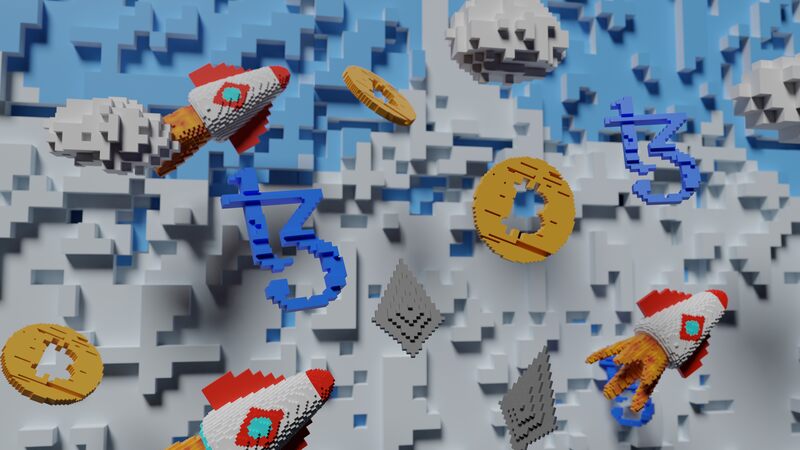
Exploring the Promise of Web 3 – The Future of the Internet
In the digital landscape, we often hear about the concept of Web 3. But what is it, and how does it differ from its predecessor, Web 2? In this blog, we’ll dive into this new world understanding its components, its use cases, challenges, advantages, and what the future holds.
Understanding Web 3
Web 3 represents the next evolutionary step in the development of the internet. It’s an internet where users have more control over their data, where decentralisation and blockchain technology play a crucial role. Web 3 aims to create a more open and user-centric digital environment.
Web 3 builds on the foundation of Web 2 but with a fundamental shift. In Web 2, data is often centralised and controlled by tech giants, leading to concerns about user privacy, surveillance, and data ownership. In contrast, Web 3 seeks to return the power to individuals, emphasizing privacy, data ownership, and a more decentralized approach.
How Web 3 Differs from Web 2

To understand Web 3, it’s essential to recognize how it differs from Web 2:
1. Data Ownership
Web 2 platforms often collect and monetize user data without clear consent. Web 3 aims to give users more control over their data and allow them to decide who accesses their information.
2. Decentralization
In Web 2, data is typically stored on centralised servers controlled by corporations. In this new version the data is distributed across many nodes, reducing the risk of censorship and control. This decentralisation makes it more resistant to single points of failure.
3. Privacy
Privacy is a significant concern in Web 2 due to the amount of personal data collected. Web 3 prioritises user privacy, reducing the surveillance often associated with Web 2 platforms.
4. User Control
In Web 3, users have more control over their data and digital assets. They can choose what they share and who accesses their information. Smart contracts and blockchain technology enable more control in terms of transactions and agreements.
Key Components of Web 3

Web 3 encompasses several key components that drive its philosophy:
1. Decentralization
At the core of Web 3 is decentralisation. Unlike Web 2 platforms, which centralise data, it relies on decentralised networks and blockchain technology. This means data is distributed across many nodes, reducing the risk of censorship and control.
2. Blockchain Technology
Blockchain is a foundational technology in Web 3. It enables the creation of secure, immutable ledgers, ensuring transparency and data integrity. Blockchain also powers the creation of cryptocurrencies and smart contracts, further enhancing capabilities.
3. Smart Contracts
Smart contracts are self-executing contracts with the terms of the agreement between buyer and seller being directly written into code. These contracts automate transactions and agreements, reducing the need for intermediaries. They play a crucial role in Web 3 by enabling trustless and automated interactions.
Use Cases of Web 3

Web 3 is not a distant dream; it’s already making waves in various industries. Let’s explore some notable use cases:
Decentralized Finance (DeFi)
W3 enables the creation of DeFi platforms, which allow users to participate in financial services like lending, borrowing, and trading without intermediaries. DeFi applications are decentralised and open, offering more accessible and transparent financial services.
Non-Fungible Tokens (NFTs)
The concept of NFTs, unique digital assets, is a creation of W3. These tokens represent ownership of digital art, collectibles, music, and more. NFTs are often created and traded on blockchain platforms, proving authenticity and provenance.
Digital Identity
Web 3 can redefine digital identity by giving users control over their personal information. With blockchain-based identity solutions, individuals can own and selectively share their identity data, enhancing privacy and reducing reliance on centralised identity providers.
Supply Chain Management
Web 3 can revolutionize supply chain management by providing an immutable and transparent ledger of goods’ movement. This technology enables tracking from the source to the end user, reducing fraud and ensuring authenticity.
Social Media
This new tech envisions a shift in the way social media operates. Decentralised social platforms built on blockchain offer users more control over their data, enabling them to monetise their content and decide how their data is used.
Advantages of Web 3

Web 3 offers numerous advantages that align with its principles:
Enhanced Privacy
Prioritises user privacy. By enabling users to own and control their data, it reduces the surveillance often associated with Web 2 platforms. Data breaches and unauthorized access are less likely in a decentralized environment.
User Control
Users have more control over their data and digital assets. They can choose what they share, who accesses their information, and even monetize their data or content directly.
Transparency
Blockchain technology ensures transparency in transactions and data. Anyone can verify the integrity of data stored on the blockchain. This is crucial for trust in financial transactions, provenance of digital assets, and secure agreements through smart contracts.
Reduced Intermediaries
The new tech aims to reduce the need for intermediaries in various processes. In DeFi, for example, financial transactions occur directly between users without banks or traditional financial institutions acting as intermediaries. This can lead to lower costs and faster transactions.
Trustless Transactions
With the use of smart contracts, it enables trustless transactions. Parties can engage in agreements without relying on trust in a central authority. The code of the contract itself ensures execution.
Challenges in Web 3

This new tech is not without its challenges. Let’s explore some of the hurdles it faces:
Usability
The transition can be complex for the average user. Cryptocurrency wallets, managing private keys, and interacting with blockchain applications often require technical knowledge. User-friendly interfaces and education are essential to make it accessible to a broader audience.
Scalability
Scalability issues in blockchain networks need to be addressed to handle the high number of transactions efficiently. As it gains popularity, solutions like sharding, layer-2 scaling, and improved consensus mechanisms become critical.
Regulatory Uncertainty
Governments and regulatory bodies worldwide are still adapting to blockchain and cryptocurrency technology. This can lead to uncertainty and legal challenges. Striking a balance between innovation and regulation is an ongoing challenge in the ecosystem.
Future of Web 3

The future looks promising. As the technology matures and solutions to its challenges are found, we can expect it to continue reshaping the digital world. It might become the standard for a more open, user-centric internet.
DeFi (Decentralised Finance)
The growth of decentralized finance platforms that allow users to borrow, lend, and trade cryptocurrencies without intermediaries is a significant trend. DeFi is continually evolving with new projects and innovations.
NFTs (Non-Fungible Tokens)
The rise of non-fungible tokens continues to gain momentum. Artists, creators, and collectors are exploring NFTs as a new way to create, trade, and invest in unique digital assets.
Cross-Industry
Integration
Web 3 is witnessing increased integration across various industries, from healthcare to supply chain management and beyond. Blockchain technology is no longer limited to the financial sector; it’s finding applications in diverse fields.
Enhanced Privacy Features
With a growing focus on privacy, Web 3 projects are developing enhanced privacy features. Technologies like zero-knowledge proofs and privacy-focused blockchains aim to protect data while maintaining transparency and security.
Explore the Future with Wrightway Digital
Wrightway Digital is at the forefront of Web 3 innovations. Discover how we can help you navigate this transformative digital landscape. Contact us today to explore the endless possibilities and stay ahead of the curve!
In conclusion, this is the next chapter in the internet’s evolution, where users have more control, data is decentralised, and privacy is paramount. As it continues to develop, it’s not just a technological shift but a philosophical one—putting power and ownership back in the hands of users.
The promise of lies in its ability to transform the way we interact with digital technologies, from financial transactions to identity management, content creation, and more. While challenges persist, the potential for a more open and user-centric digital future is within reach.
FAQs
FAQ 1: What is Web 3?
Web 3 is the next evolution of the internet, emphasizing decentralization, privacy, and user data ownership.
FAQ 2: How does it differ from Web 2?
It differs by decentralising data, emphasising user privacy, and giving users control over their data, while Web 2 is more centralised.
FAQ 3: What are some use cases?
Web 3 enables DeFi platforms, NFTs, digital identity solutions, supply chain management improvements, and a shift in social media towards decentralization.
FAQ 4: What advantages does it offer?
Web 3 prioritises user privacy, data ownership, user control, transparency, and reducing the need for intermediaries.
FAQ 5: What challenges are there?
Challenges include usability, scalability, and regulatory uncertainty. Solutions are actively being developed to overcome these obstacles.











